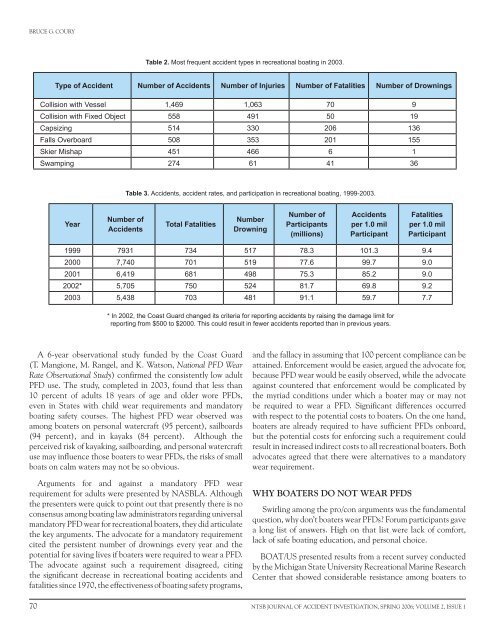Journal of Accident Investigation
Journal of Accident Investigation
Journal of Accident Investigation
You also want an ePaper? Increase the reach of your titles
YUMPU automatically turns print PDFs into web optimized ePapers that Google loves.
BRUCE G. COURY<br />
A 6-year observational study funded by the Coast Guard<br />
(T. Mangione, M. Rangel, and K. Watson, National PFD Wear<br />
Rate Observational Study) confirmed the consistently low adult<br />
PFD use. The study, completed in 2003, found that less than<br />
10 percent <strong>of</strong> adults 18 years <strong>of</strong> age and older wore PFDs,<br />
even in States with child wear requirements and mandatory<br />
boating safety courses. The highest PFD wear observed was<br />
among boaters on personal watercraft (9 percent), sailboards<br />
(94 percent), and in kayaks (84 percent). Although the<br />
perceived risk <strong>of</strong> kayaking, sailboarding, and personal watercraft<br />
use may influence those boaters to wear PFDs, the risks <strong>of</strong> small<br />
boats on calm waters may not be so obvious.<br />
Arguments for and against a mandatory PFD wear<br />
requirement for adults were presented by NASBLA. Although<br />
the presenters were quick to point out that presently there is no<br />
consensus among boating law administrators regarding universal<br />
mandatory PFD wear for recreational boaters, they did articulate<br />
the key arguments. The advocate for a mandatory requirement<br />
cited the persistent number <strong>of</strong> drownings every year and the<br />
potential for saving lives if boaters were required to wear a PFD.<br />
The advocate against such a requirement disagreed, citing<br />
the significant decrease in recreational boating accidents and<br />
fatalities since 1970, the effectiveness <strong>of</strong> boating safety programs,<br />
Table 2. Most frequent accident types in recreational boating in 2003.<br />
Type <strong>of</strong> <strong>Accident</strong> Number <strong>of</strong> <strong>Accident</strong>s Number <strong>of</strong> Injuries Number <strong>of</strong> Fatalities Number <strong>of</strong> Drownings<br />
Collision with Vessel 1,469 1,063 70 9<br />
Collision with Fixed Object 558 491 50 19<br />
Capsizing 514 330 206 136<br />
Falls Overboard 508 353 201 155<br />
Skier Mishap 451 466 6 1<br />
Swamping 274 61 41 36<br />
Year<br />
Number <strong>of</strong><br />
<strong>Accident</strong>s<br />
Table 3. <strong>Accident</strong>s, accident rates, and participation in recreational boating, 1999-2003.<br />
Total Fatalities<br />
Number<br />
Drowning<br />
Number <strong>of</strong><br />
Participants<br />
(millions)<br />
<strong>Accident</strong>s<br />
per 1.0 mil<br />
Participant<br />
and the fallacy in assuming that 100 percent compliance can be<br />
attained. Enforcement would be easier, argued the advocate for,<br />
because PFD wear would be easily observed, while the advocate<br />
against countered that enforcement would be complicated by<br />
the myriad conditions under which a boater may or may not<br />
be required to wear a PFD. Significant differences occurred<br />
with respect to the potential costs to boaters. On the one hand,<br />
boaters are already required to have sufficient PFDs onboard,<br />
but the potential costs for enforcing such a requirement could<br />
result in increased indirect costs to all recreational boaters. Both<br />
advocates agreed that there were alternatives to a mandatory<br />
wear requirement.<br />
WHY BOATERS DO NOT WEAR PFDS<br />
Fatalities<br />
per 1.0 mil<br />
Participant<br />
1999 7931 734 517 78.3 101.3 9.4<br />
2000 7,740 701 519 77.6 99.7 9.0<br />
2001 6,419 681 498 75.3 85.2 9.0<br />
2002* 5,705 750 524 81.7 69.8 9.2<br />
2003 5,438 703 481 91.1 59.7 7.7<br />
* In 2002, the Coast Guard changed its criteria for reporting accidents by raising the damage limit for<br />
reporting from $500 to $2000. This could result in fewer accidents reported than in previous years.<br />
Swirling among the pro/con arguments was the fundamental<br />
question, why don’t boaters wear PFDs? Forum participants gave<br />
a long list <strong>of</strong> answers. High on that list were lack <strong>of</strong> comfort,<br />
lack <strong>of</strong> safe boating education, and personal choice.<br />
BOAT/US presented results from a recent survey conducted<br />
by the Michigan State University Recreational Marine Research<br />
Center that showed considerable resistance among boaters to<br />
70 NTSB JOURNAL OF ACCIDENT INVESTIGATION, SPRING 2006; VOLUME 2, ISSUE 1
















